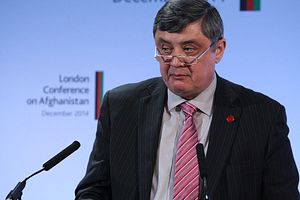Over the past two years, a cottage industry of Russian officials overblowing the ISIS threat to Afghanistan – and Central Asia, and Russia – has seen a marked surge. In late 2014, the head of the Collective Security Treaty Organization (CSTO), Nikolai Bordyuzha, claimed militants were attempting to create an “underground extremist state” somewhere in Central Asia. And Yevgeny Satanovsky, president of the Russian Institute for Middle East Studies, was described as predicting a “catastrophic wave of violence” in a 2014 interview.
None, however, have slathered on the putative threats to the extent of Zamir Kabulov, Moscow’s special envoy to Kabul. Kabulov has built a reputation for his outsized, outlandish claims surrounding ISIS’s threat to and via Afghanistan – and his latest commentary does nothing to break that pattern.
According to the Kremlin-financed RT, Kabulov offered an estimate last week about ISIS’s apparent strength in Afghanistan. “There are now 10,000 [ISIS] fighters in Afghanistan,” Kabulov said. “A year ago there was a hundred. This growth over a year is spectacular.”
A few days later, Bordyuzha backed Kabulov’s assessment almost verbatim. As another Kremlin-funded outlet, Sputnik, wrote, Bordyuzha said that “[a]ccording to some figures today, there are around 10,000 [ISIS militants], though one year ago there were only a few hundred. Most are coming naturally from being squeezed out of Syria and Iraq into Afghanistan. This is a serious threat to us.”
Kabulov didn’t cite any sources for his claims, and didn’t note that his estimate far outstrips other official estimates of ISIS’s strength in Afghanistan. Moreover, Kabulov has apparently forgotten the earlier numbers he’d bandied about.
In late December 2014, the Russian official noted that local fighters loyal to ISIS – whose spillover into Central Asia was “inevitable” – had established a pair of “beachheads” in Afghanistan, alongside the borders with Tajikistan and Turkmenistan. Per Kabulov, these two contingents totaled upwards of 7,500 fighters – far more than the “hundreds” the official now says existed some 12 months ago. RT further writes that Kabulov had estimated the ISIS fighters in Afghanistan at 3,500 last October, adding to the confusion.
Kabulov doesn’t explain this discrepancy, or note whether or not any of these fighters have already crossed into Central Asia. Still, he made sure to detail who these fighters’ final targets were. “The Afghan branch of [ISIS] is definitely specialized against Central Asia,” Kabulov said. “Russian is even one of their working languages. They are being trained against Central Asia and Russia.” That is to say, per Kabulov, Afghanistan is now hosting some 10,000 ISIS militants aimed squarely at Central Asia and Russia.
Kabulov’s commentary, unsurprisingly, comes on the heels of the recent CSTO exercises held in Dushanbe, which saw some 1,500 troops attempt the elimination of ISIS fighters in a fictionalized neighboring country. Indeed, if anything, it seems we’re guaranteed a spike in estimates about Afghanistan-based ISIS militants any time the CSTO gets together.
What number Kabulov comes up with next, only time will tell.
































